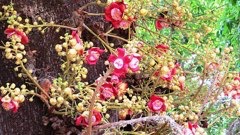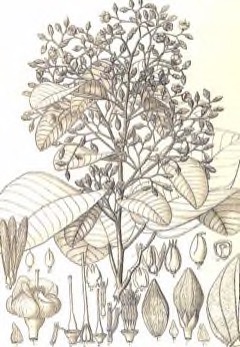 |
|
panoramio.com/photo/129897213 |
 |
| http://www.edibleplants.org |
Translate this page:
Summary
Shorea siamensis is a deciduous tree growing up to 30 m in height with a straight and often branchless bole that can be up to 80 cm in diameter. It can be found in Southeast Asia. When fully established, it is tolerant to drought. There is no edible part. Bark decoction is used against dysentery. The tree is a source of red resin which is used for caulking boats. The wood of this species is used for heavy construction, bows, etc.
Physical Characteristics

 Shorea siamensis is a deciduous Tree growing to 18 m (59ft) by 15 m (49ft) at a fast rate.
Shorea siamensis is a deciduous Tree growing to 18 m (59ft) by 15 m (49ft) at a fast rate.
See above for USDA hardiness. It is hardy to UK zone 10.
Suitable for: light (sandy) and medium (loamy) soils, prefers well-drained soil and can grow in nutritionally poor soil. Suitable pH: mildly acid and neutral soils and can grow in very acid soils.
It cannot grow in the shade. It prefers dry or moist soil and can tolerate drought.
UK Hardiness Map
US Hardiness Map
Synonyms
Hopea suava Wall. ex A.DC. Pentacme malayana King Pentacme siamensis (Miq.) Kurz Pentacme suavis Wal
Plant Habitats
Edible Uses
References More on Edible Uses
Medicinal Uses
Plants For A Future can not take any responsibility for any adverse effects from the use of plants. Always seek advice from a professional before using a plant medicinally.
Astringent Dysentery
The bark is astringent. A decoction is used in the treatment of dysentery[730 ].
References More on Medicinal Uses
The Bookshop: Edible Plant Books
Our Latest books on Perennial Plants For Food Forests and Permaculture Gardens in paperback or digital formats.

Edible Tropical Plants
Food Forest Plants for Hotter Conditions: 250+ Plants For Tropical Food Forests & Permaculture Gardens.
More

Edible Temperate Plants
Plants for Your Food Forest: 500 Plants for Temperate Food Forests & Permaculture Gardens.
More

More Books
PFAF have eight books available in paperback and digital formats. Browse the shop for more information.
Shop Now
Other Uses
Furniture Resin Waterproofing Wood
Other Uses: A red resin is obtained from the tree[506 ]. It is used for caulking boats[730 ]/ The bark contains 9% tannin and the wood 6%. This is regarded as too little to be of commercial importance[404 ]. The heartwood is yellowish-brown turning to brownish-red or dark brown; it is clearly demarcated from the red sapwood[404 , 598 ]. Texture is medium to coarse. In comparison to most other species in this family, the wood is very hard, heavy, strong and very durable[46 , 404 , 451 ]. Graveyard tests have indicated a life of over 270 months for the wood, whilsr untreated sleepers have lasted for 15 years in the ground[404 ]. Sawing and working is rather difficult and the wood is quite tolerant to treatment, however it can take a good polish on a well finished surface[404 ]. It is used for heavy construction[46 , 404 ]. A highly prized wood, it is used for valuable furniture, house and long term construction, bows etc[506 , 598 ]. It is regarded as an excellent wood for sleepers[404 ].
Special Uses
References More on Other Uses
Cultivation details
A plant of lowland areas in the moist tropics, it grows at elevations from sea level to over 1,000 metres. It prefers a tropical monsoon climate with a mean annual rainfall of 1,250 - 2,000mm, with a well pronounced wet season and a dry season of up to 6 months[404 , 451 ] Requires a sunny position[404 ]. The plant has adapted to very dry conditions and mainly grows on shallow poor, and rocky sand soils, or on limestone soils with an acid to neutral pH[404 , 598 ]. Established plants are drought tolerant[598 ]. The plant grows in areas that are often subject to forest fires. It has adapted to be able to survive these fires and by the time it is large it is very resistant[404 ]. In areas with high fire frequencies, the species grows shrubby until the root system is vigorous enough to send up a strong terminal shoot, which rapidly develops a thick rough, fire resistant bark at the base[404 ].
References Carbon Farming Information and Carbon Sequestration Information
Temperature Converter
Type a value in the Celsius field to convert the value to Fahrenheit:
Fahrenheit:
The PFAF Bookshop
Plants For A Future have a number of books available in paperback and digital form. Book titles include Edible Plants, Edible Perennials, Edible Trees,Edible Shrubs, Woodland Gardening, and Temperate Food Forest Plants. Our new book is Food Forest Plants For Hotter Conditions (Tropical and Sub-Tropical).
Shop Now
Plant Propagation
We have no specific information for this species - the information below is a general guide for the genus. Seed - best sown as soon as possible. It does not require pre-treatment, but it is recommended to soak the seed for 12 hours prior to sowing[325 ]. The seeds are sown in seedbeds, where they are covered with a mixture of sand and soil (1:1) or with a thin layer of sawdust[325 ]. Germination of fresh seeds is usually good and rapid. About two weeks after germination, when the seedlings are 5 - 6cm tall, they are potted up into individual containers about 15 x 23cm with good drainage holes at their base[325 ]. It is normally recommended to use a mixture of forest soil and sand (at a ratio of 3:1) as the potting medium in order to introduce the appropriate mycorrhiza to the roots. The seedlings are placed in 50 - 60% sunlight and watered twice daily[325 ]. Seedlings can be planted out when 30 - 40cm tall - harden the seedlings off in full sunlight for one month prior to planting[325 ].
Other Names
If available other names are mentioned here
Native Range
TROPICAL ASIA: Cambodia, Laos, Myanmar, Thailand, Vietnam, Malaysia (Perlis)
Weed Potential
Right plant wrong place. We are currently updating this section.
Please note that a plant may be invasive in one area but may not in your area so it's worth checking.
Conservation Status
IUCN Red List of Threatened Plants Status : Status: Lower Risk/least concern

Growth: S = slow M = medium F = fast. Soil: L = light (sandy) M = medium H = heavy (clay). pH: A = acid N = neutral B = basic (alkaline). Shade: F = full shade S = semi-shade N = no shade. Moisture: D = dry M = Moist We = wet Wa = water.
Now available:
Food Forest Plants for Mediterranean Conditions
350+ Perennial Plants For Mediterranean and Drier Food Forests and Permaculture Gardens.
[Paperback and eBook]
This is the third in Plants For A Future's series of plant guides for food forests tailored to
specific climate zones. Following volumes on temperate and tropical ecosystems, this book focuses
on species suited to Mediterranean conditions—regions with hot, dry summers and cool, wet winters,
often facing the added challenge of climate change.
Read More
Expert comment
Author
Miq.
Botanical References
Links / References
For a list of references used on this page please go here
A special thanks to Ken Fern for some of the information used on this page.
Readers comment
| Add a comment |
|
If you have important information about this plant that may help other users please add a comment or link below. Only comments or links that are felt to be directly relevant to a plant will be included. If you think a comment/link or information contained on this page is inaccurate or misleading we would welcome your feedback at [email protected]. If you have questions about a plant please use the Forum on this website as we do not have the resources to answer questions ourselves.
* Please note: the comments by website users are not necessarily those held by PFAF and may give misleading or inaccurate information.
To leave a comment please Register or login here All comments need to be approved so will not appear immediately.
|
Subject : Shorea siamensis
|
|
|
|